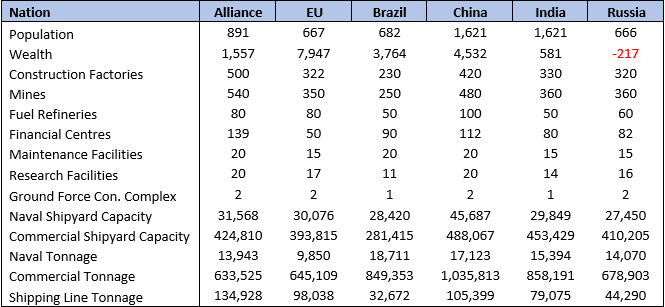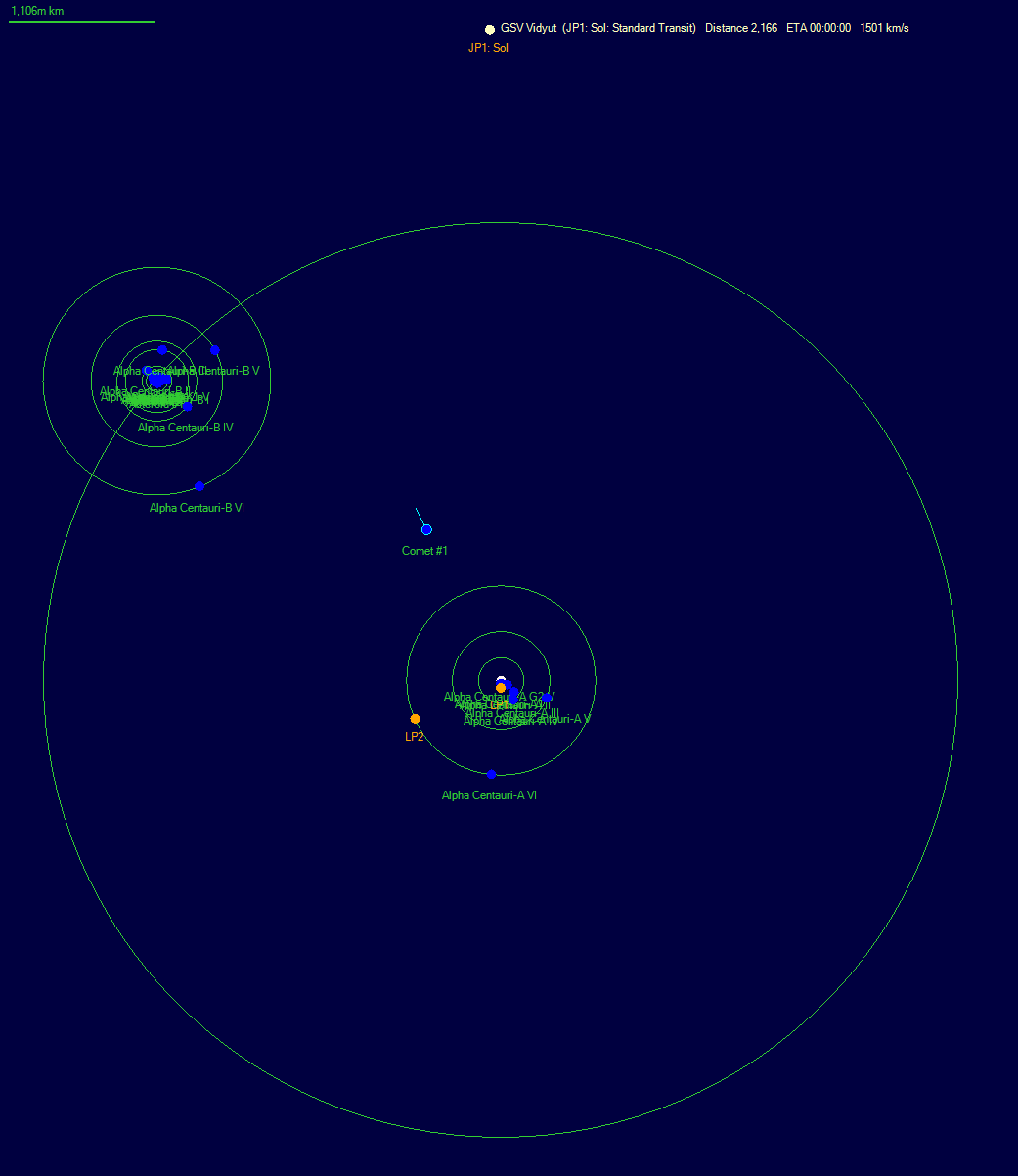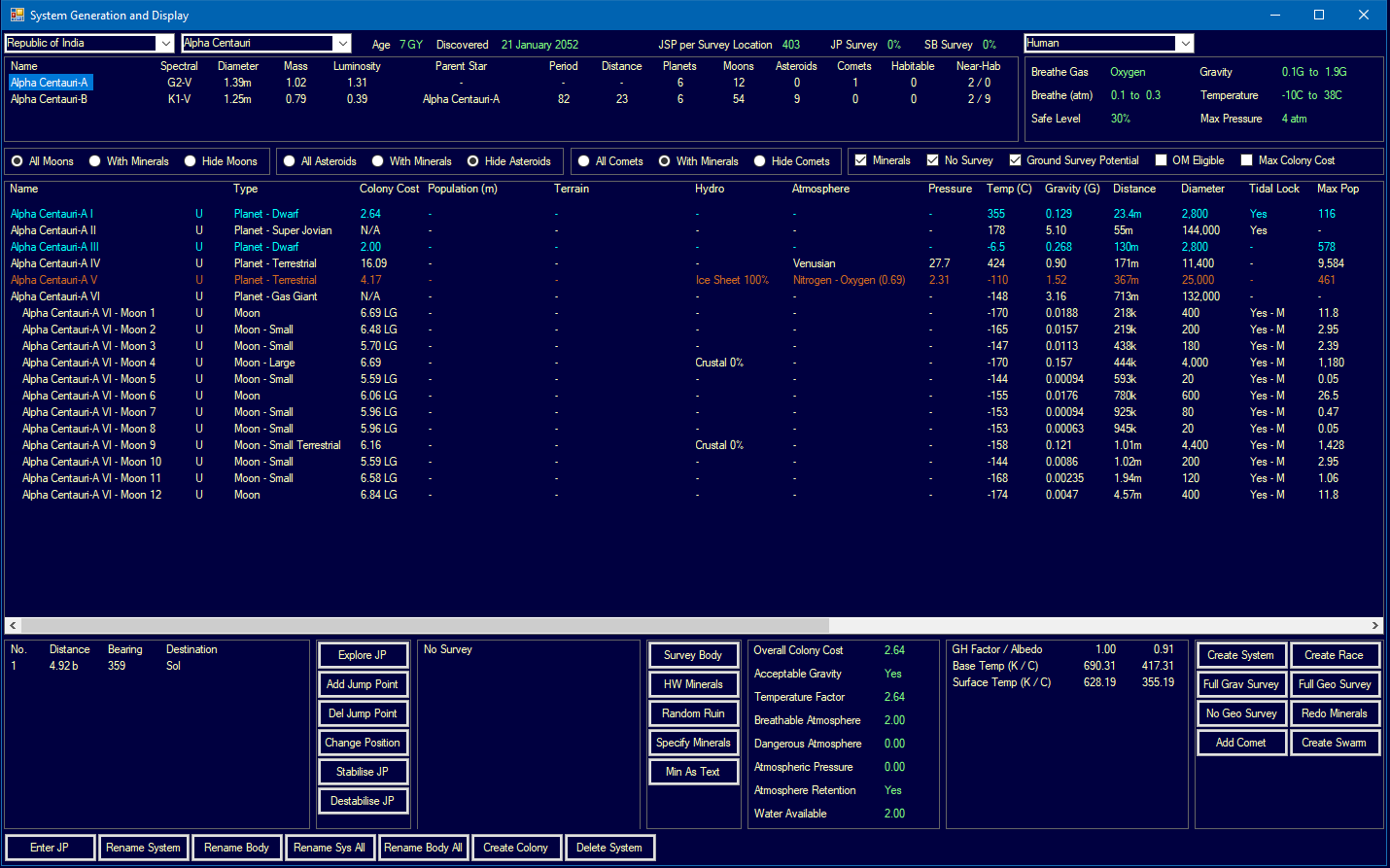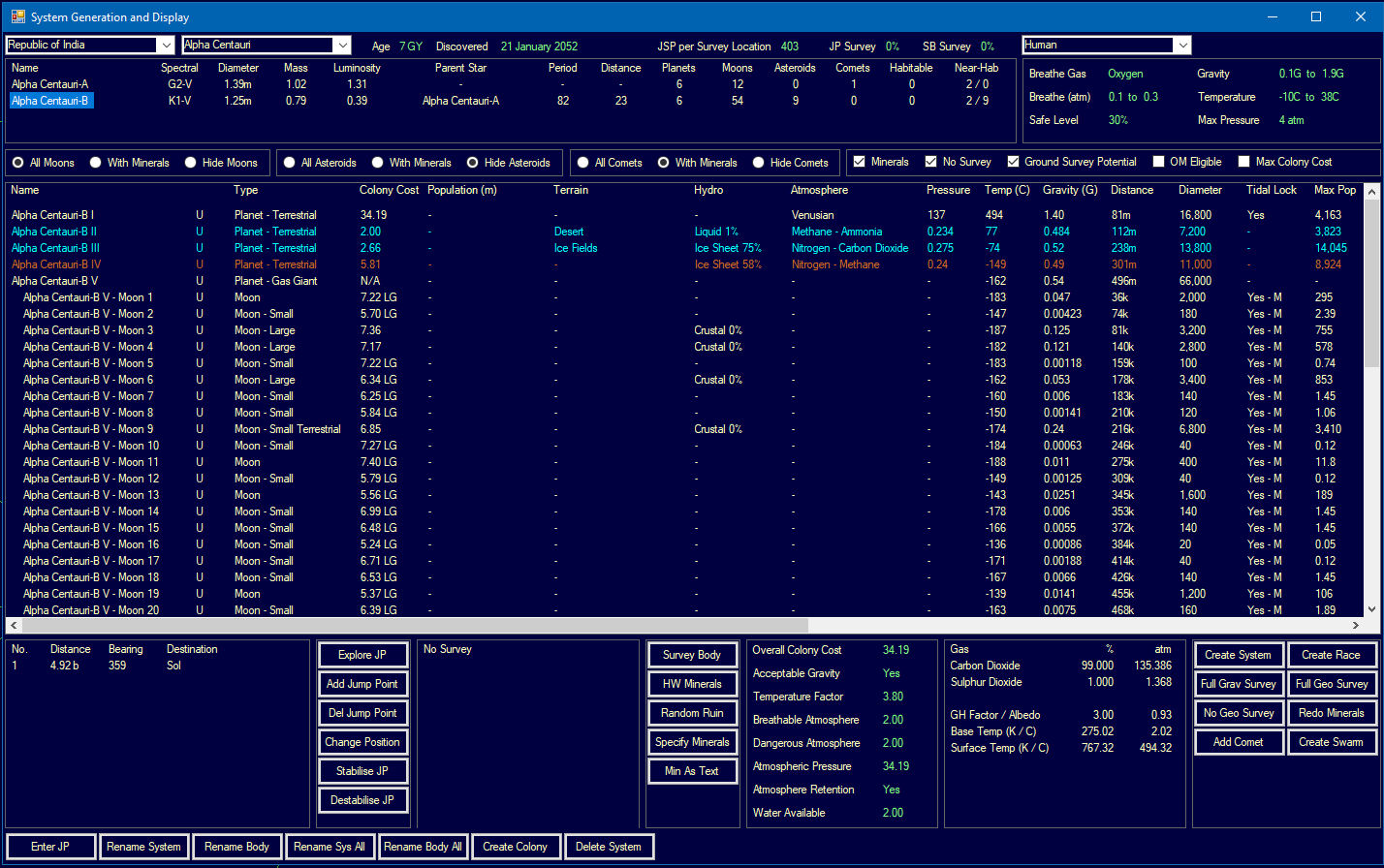18 May 2050Baler Carrier Lines, a Colonial Alliance Shipping Line, launches a small freighter. The Russian Federation launches a colony ship and establishes its own colony on Mercury.
22 June 2050Qin Transport Group, a Chinese Shipping Line, launches a small freighter. The Colonial Alliance completes research into the tractor beam, a technology that will allow space stations, shipyards or even ships to be towed by a ship equipped with a tractor beam. Work begins on design for a tug.
17 July 2050A civilian mining colony of the Colonial Alliance is established on Saturn’s moon Iapetus. The moon has 300,000 tons of 0.8 Duranium, 210,000 tons of 0.7 Vendarite and 40,000 tons of 0.7 Uridium. Given the high expenditure of the preparations for Exodus, the Alliance decides to boost tax revenues rather than buying the civilian minerals.
27 July 2050The Chinese shipping line launches a colony ship. Three powers, the Colonial Alliance, the People’s Republic and the Russian Federation, have colony ships and small settlements on Mercury. The Alliance and the People’s Republic have active shipping lines, but only China has a civilian colony ship.
2 August 2050Qin Transport Group launches a second colony ship. The early lead by the Chinese in civilian shipping could be significant for the long-term situation post-Exodus.
9 August 2050India becomes the first to lay down a jump-capable gravitational survey vessel. The Vidyut is a vessel designed within constraints rather than with specific capabilities in mind. With only thirteen research facilities, India lacks the research bandwidth of some of the other powers so her leaders do not want to wait until jump drive efficiency improves, which would take almost a year. Her 4000-ton capacity jump drive therefore require considerable internal space. The largest shipyard is reserved for eventual Indian warships, which are intended to counter the inevitable aggressive of powers such as Russia and China once the Exodus is well underway, so the survey ship has to be built within the size of the second Indian naval yard. The design of the Vidyut is based on the 2850 ton Sandhayak class Geological Survey Vessel, and therefore has an engine intended for a smaller ship, which makes the Vidyut thirty percent slower than her predecessor. One option considered was to remove a gravitational survey sensor and design a larger engine specifically for the Vidyut, but that idea was discarded due to the research time, plus the impact on the vessel’s core capability. India wishes to be at the forefront of interstellar exploration so it made no sense to be the first to build a gravitational survey ship, yet take so long in surveying that other nations gained an advantage. Finally, the thermal sensor of her predecessor was removed due to a lack of internal space and a desire to have the maximum fuel possible, leaving the Vidyut effectively blind. Despite all its faults, the design is finalised and first Vidyut begins construction.
Vidyut class Gravitational Survey Vessel 4,000 tons 95 Crew 536.3 BP TCS 80 TH 120 EM 0
1501 km/s JR 3-50 Armour 1-22 Shields 0-0 HTK 23 Sensors 0/0/2/0 DCR 3 PPV 0
Maint Life 4.58 Years MSP 251 AFR 43% IFR 0.6% 1YR 19 5YR 292 Max Repair 100 MSP
Commander Control Rating 1 BRG
Intended Deployment Time: 45 months Morale Check Required
Akkur-Sheladia AS-4000 Military Jump Drive Max Ship Size 4000 tons Distance 50k km Squadron Size 3
Rajwal-Sangra RS-120E Nuclear Pulse Engine (1) Power 120 Fuel Use 31.00% Signature 120 Explosion 7%
Fuel Capacity 770,000 Litres Range 111.8 billion km (862 days at full power)
Gravitational Survey Sensors (2) 2 Survey Points Per Hour
14 August 2050Baler Carrier Lines of the Colonial Alliance launches a small colony ship.
8 September 2050India launches its first Khanjar class colony ship.
7 December 2050The Russian Federation is the second nation to begin construction of a gravitational survey ship. Compared to the Indian Vidyut, the Project 005 ‘Burevestnik’ class Gravitational Survey Vessel has been designed with considerably more freedom. This is primarily due to Tolya Belkin, the leading expert on power and propulsion systems in any of the six nations. Russian estimates of his skills suggest a project managed by Belkin will be completed three times as quickly as one led by a scientist with no specialist skills. Belkin has improved Russian jump drive efficiency to the point where an engine takes up only one fifth of the jump capacity, compared to one fourth for the Indian jump drive. He has also designed a large, 1600-ton engine specifically for the Project 005.
Project 005 Burevestnik class GSV 4,750 tons 109 Crew 594.3 BP TCS 95 TH 192 EM 0
2021 km/s JR 3-50 Armour 1-25 Shields 0-0 HTK 26 Sensors 5/0/2/0 DCR 4 PPV 0
Maint Life 4.63 Years MSP 312 AFR 45% IFR 0.6% 1YR 24 5YR 357 Max Repair 100 MSP
Kapitan vtorogo ranga Control Rating 1 BRG
Intended Deployment Time: 48 months Morale Check Required
Nikolayev-Sorokin Thrust NST-475 Military Jump Drive Max Ship Size 4750 tons Distance 50k km Squadron Size 3
NPO Energomash RD-192E Nuclear Pulse Drive (1) Power 192 Fuel Use 24.51% Signature 192 Explosion 7%
Fuel Capacity 790,000 Litres Range 122.1 billion km (699 days at full power)
Commercial Thermal Sensor (1) Sensitivity 5 Detect Sig Strength 1000: 17.7m km
Gravitational Survey Sensors (2) 2 Survey Points Per Hour
27 December 2050The Russian shipping company, Gavrilov Lines, launches a small colony ship. A second Colonial Alliance civilian mining colony is established, this time on the comet Van Biesbroeck.
1 January 2051The Indian shipping company, Burujula Container Services, launches a small colony ship.
25 January 2051The European Union launches Achéron and Vulcain, its first two Geosurvey ships. Although the EU is lagging behind the other nations in terms of Geosurvey construction, the Acherons are among the most capable ships of their type and mount four geological survey sensors. Despite its slowness is completing the Achérons, the European Union is more advanced in other areas. European Léopard freighters have twice the carrying capacity of most nations, with the exception of India which has constructed similar size ships, while its Panthère class colony ships can transport 70,000 colonists, rather than the 50,000 capacity chosen by all the other nations. The EU is concentrating on building quality ships, rather than being the first to deploy a design.
8th February 2051With the above philosophy in mind, the European Union lays down the first Antarès class Survey Cruiser at the Lalande Enterprises Shipyard. It is larger and more capable than either its Russian or Indian counterparts. The European Union followed the example of Russia and waited until improved jump drive efficiency was available before designed its first jump drive.
Antarès class Survey Cruiser 6,000 tons 147 Crew 795.7 BP TCS 120 TH 240 EM 0
2003 km/s JR 3-50 Armour 1-29 Shields 0-0 HTK 35 Sensors 10/0/3/0 DCR 6 PPV 0
Maint Life 5.17 Years MSP 498 AFR 48% IFR 0.7% 1YR 31 5YR 466 Max Repair 100 MSP
Capitaine de frégate Control Rating 1 BRG
Intended Deployment Time: 48 months Morale Check Required
Langlois-Matthieu LM-600 Military Jump Drive Max Ship Size 6000 tons Distance 50k km Squadron Size 3
Michaud Aeromarine MA-240E (1) Power 240 Fuel Use 21.92% Signature 240 Explosion 7%
Fuel Capacity 810,000 Litres Range 111 billion km (641 days at full power)
Thermal Sensor TH2-10 (1) Sensitivity 10 Detect Sig Strength 1000: 25m km
Gravitational Survey Sensors (3) 3 Survey Points Per Hour
7 April 2051The Colonial Alliance is the fourth nation to design and begin construction on a gravitational survey ship. The Colonial Alliance has not made the same advances in jump drive efficiency as Russia and the European Union so while its design is similar in size to the European Antarès class, it is less capable due to a reduction in available internal space. Colonial designers decided that three survey sensors were necessary, as well as keeping the speed close to 2000 km/s. Therefore, they elected for lower endurance than other nations, particularly in terms of fuel, with the intention of eventually deploying tankers to support survey operations.
Newton class Gravitational Survey Vessel 6,000 tons 155 Crew 787.8 BP TCS 120 TH 224 EM 0
1868 km/s JR 3-50 Armour 1-29 Shields 0-0 HTK 36 Sensors 5/0/3/0 DCR 6 PPV 0
Maint Life 4.81 Years MSP 492 AFR 48% IFR 0.7% 1YR 35 5YR 526 Max Repair 114 MSP
Commander Control Rating 1 BRG
Intended Deployment Time: 42 months Morale Check Required
BAE Systems M600 Military Jump Drive Max Ship Size 6000 tons Distance 50k km Squadron Size 3
Rolls Royce RR-224 Nuclear Pulse Drive (1) Power 224 Fuel Use 18.45% Signature 224 Explosion 7%
Fuel Capacity 560,000 Litres Range 91.1 billion km (564 days at full power)
Thermal Sensor (1) Sensitivity 5 Detect Sig Strength 1000: 17.7m km
Gravitational Survey Sensors (3) 3 Survey Points Per Hour
The People’s Republic of China begins construction of its gravitational survey class at the same time as the Colonial Alliance. The Type 005 is a bare bones design similar in concept to the Indian Vidyut, although with even less endurance than the Colonial Newton. As with the Indians and Colonials, the Chinese have the constraint of limited jump drive efficiency tech, although in this case Chinese designers have opted to use their limited internal space to maintain a relatively high speed. They also decided to include two very small sensors, one EM and one Thermal, which in combination are still smaller than the single sensor on the Russian, Colonial and European designs. The Chinese do have one advantage however. Two Type 005s are under construction, compared to only one for each of the other four gravitational survey ship classes.
Type 005 class Gravitational Survey Vessel 4,400 tons 108 Crew 542.6 BP TCS 88 TH 180 EM 0
2045 km/s JR 3-50 Armour 1-23 Shields 0-0 HTK 24 Sensors 2/2/2/0 DCR 3 PPV 0
Maint Life 3.47 Years MSP 231 AFR 52% IFR 0.7% 1YR 29 5YR 440 Max Repair 100 MSP
Zhong Xiao Control Rating 1 BRG
Intended Deployment Time: 36 months Morale Check Required
Cheng-Qiu CQ-44 Military Jump Drive Max Ship Size 4400 tons Distance 50k km Squadron Size 3
Su-Yang SY-180E Nuclear Pulse Engine (1) Power 180 Fuel Use 25.31% Signature 180 Explosion 7%
Fuel Capacity 500,000 Litres Range 80.8 billion km (457 days at full power)
Small EM Sensor (1) Sensitivity 2 Detect Sig Strength 1000: 11.2m km
Small Thermal Sensor (1) Sensitivity 2 Detect Sig Strength 1000: 11.2m km
Gravitational Survey Sensors (2) 2 Survey Points Per Hour
27 April 2051A civilian mining colony of the Russian Federation is established on Iapetus, alongside that of the Colonial Alliance.
16 June 2051The European Union launches its first Panthère class colony ship.
25 July 2051A European colony is established on Mercury. Shortly thereafter the European civilian shipping line, Crevecoeur Interstellar Shipping, launches a small freighter. All nations except Brazil now have a settlement on the innermost planet.
13 August 2051A second shipping line is founded in the People’s Republic of China – Liao Freight and Trading.
12 October 2051Brazil launches its first colony ship and subsequently founds a colony on Mercury. The colony cost on Mercury continues to fall gradually and is now 2.88.
20 November 2051The Colonial Alliance and the Russia Federation both begin construction of their first troop transports. Both ships are similar in size and function. The Russian Project 006 ‘Peresvet’ class Landing Ship is shown below. The Colonial Nagara class Troop Transport has the same capacity, is 2500 tons smaller and has a speed of 1881 km/s. The immediate environmental threat to Earth has been averted, with the surface temperature recently rising above 9C, so the attention of the six nations is turning to the ruins on Mars. Each nation is researching the technology required to move ground forces to Mars and to investigate the ruins. This endeavour is likely to be far less cooperative than the terraforming efforts on Earth.
Project 006 ‘Peresvet’ class Landing Ship 23,800 tons 192 Crew 654.7 BP TCS 476 TH 960 EM 0
2017 km/s Armour 1-73 Shields 0-0 HTK 66 Sensors 5/0/0/0 DCR 1 PPV 0
MSP 17 Max Repair 40 MSP
Troop Capacity 10,000 tons Cargo Shuttle Multiplier 1
Kapitan tret'yego ranga Control Rating 1 BRG
Intended Deployment Time: 3 months
Commercial Nuclear Pulse Engine (6) Power 960 Fuel Use 7.95% Signature 160 Explosion 5%
Fuel Capacity 250,000 Litres Range 23.8 billion km (136 days at full power)
Commercial Thermal Sensor (1) Sensitivity 5 Detect Sig Strength 1000: 17.7m km
25 November 2051The Russian Federation creates the first Trans-Newtonian ground formation, the 1st Research Company, comprising ten vehicles equipped with Xenoachaeological equipment and an HQ section. Russia plans to train several such formations and deploy them to Mars.
20 December 2051The Indian gravitational survey ship Vidyut is launched from the Kanmuri Naval Shipyard. She immediately breaks orbit to begin the search for jump points in Sol. Brazil lays down a troop transport, followed by China ten days later.
16 January 2052Vidyut completes its survey of the first of thirty gravitational survey locations in Sol and immediately detects a jump point, located just outside the orbit of Saturn. As the jump point is only half a billion kilometres from Vidyut, she immediately moves to investigate.
At the dawn of the interstellar age, the relative strengths of the six nations are as follows:
 21 January 2052
21 January 2052A Colonial Alliance civilian mining colony is established on Ceres. Mineral deposits on the dwarf planet include 200,000 tons of 0.9 Duranium, 160,000 tons of 0.9 Tritanium and 44,000 tons of 1.0 Boronide.
Vidyut, under the command of Commander Satyavati Kurup, makes the first jump point transit in history. She emerges five billon kilometres from the G2-V primary of Alpha Centauri, which is orbited at 3.45 billion kilometres by an orange K-class star. The primary has six planets, comprising two terrestrial worlds, two dwarf planets, a gas giant with twelve moons and a tide-locked superjovian. One of the two dwarf planets is colony cost 2.00 but lacks both water and an atmosphere. One terrestrial world is Venusian. The other has acceptable gravity, surface water and a nitrogen – oxygen atmosphere of 0.69 atm. Unfortunately, the temperature is -110C and the water covers the entire surface in a vast ice sheet. Despite the 25,000 km diameter, the maximum population is less than five hundred million even after terraforming. It would be possible to remove some of the water over a very long period but the planet does not fulfil the requirements for Exodus, at least not for all six nations.
The companion star is currently closer to the jump point but moving away in its orbit. It also has six planets, comprising four moonless terrestrial worlds and two gas giants with fifty-four moons between them. The second planet is a colony cost 2.00 desert world with minimal water and a methane – ammonia atmosphere of 0.234 atm. Not a good prospect. Alpha Centuari-B III is colony cost 2.66, with a temperature of -74C, a nitrogen – CO2 atmosphere of 0.275 atm ice fields covering 75% of the surface. Despite these disadvantages, this world does have some possibilities. It has plentiful water, which will become oceans if the temperature warms up, the start of an atmosphere, although most of the CO2 would have to be removed, and is large enough to support a population of up to fourteen billion. Alpha Centuari-B IV is another frozen world, with a temperature of -149C and a nitrogen – methane atmosphere. Even so, it also has sufficient water and could be a long-term terraforming prospect. Humanity could have done far worse in terms of the first extra-solar system to be discovered.
Two Indian geological survey vessels are ordered to the jump point, where Vidyut will escort them through before continuing her survey of the Sol system.


